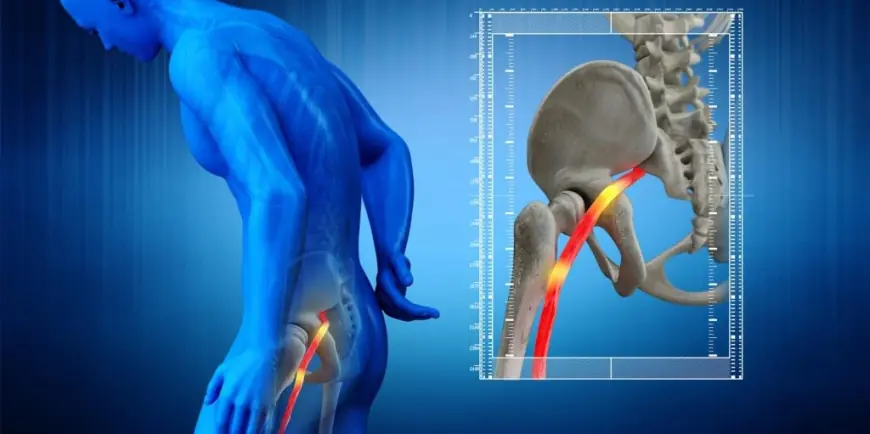How to Cure Sciatica Pain: Expert Tips for Effective Relief
Sciatica pain is a common issue that can cause a lot of discomfort and affect your daily life.

Sciatica pain is a common issue that can cause a lot of discomfort and affect your daily life. It happens when the sciatic nerve, which runs from your lower back down through your hips and legs, gets irritated or pinched. This can lead to sharp pain, numbness, tingling, and even weakness in one leg. A study indicates that sciatica is a relatively common condition, with a lifetime incidence ranging from 13% to 40%.
In this blog, we will explore proven methods for curing sciatica pain, backed by expert advice and evidence-based practices. If you are struggling with sciatica, read on to learn how to find relief and get back to living pain-free.
What is Sciatica Pain?
According to the leading orthopaedic doctor in Gurgaon, Sciatica pain refers to discomfort or pain that radiates along the sciatic nerve, which extends from the lower back through the hips and down each leg. This pain typically occurs when the sciatic nerve is compressed or irritated, often due to a herniated disc, spinal stenosis, or muscle spasms. It can range from mild to severe, and in some cases, may cause numbness, tingling, or weakness in the affected leg.
Why Does Sciatica Pain Occur?
Before exploring the sciatica pain treatment options, it is important to understand the causes of sciatica. Sciatica pain arises from compression or irritation of the sciatic nerve, usually due to:
● Herniated Disc: When a disc in the spine slips out of place, it can press on the nerve, causing pain.
● Spinal Stenosis: A condition where the spinal canal narrows, putting pressure on the sciatic nerve.
● Piriformis Syndrome: When the piriformis muscle in the buttocks becomes tight or inflamed, it can irritate the sciatic nerve.
● Degenerative Disc Disease: Aging discs can lead to nerve compression.
● Spondylolisthesis: A condition where one vertebra slips over another, compressing the nerve.
How to Cure Sciatica Pain?
- Physiotherapy for Sciatica Relief
One of the most effective ways to cure sciatica pain is through physiotherapy. A skilled physiotherapist can guide you through specific exercises that strengthen the muscles supporting your spine, improve flexibility, and reduce nerve compression.
Recommended Sciatica Exercises
● Pelvic Tilts: Lying on your back with knees bent, gently tilt your pelvis upward, pressing your lower back into the floor. Hold for a few seconds and repeat.
● Knee to Chest Stretch: Lie on your back, pulling one knee toward your chest, holding it for 20-30 seconds. This helps stretch the lower back and relieve tension.
● Piriformis Stretch: Sit cross-legged and gently lean forward to stretch the piriformis muscle, which can often cause sciatica pain if tight.
A physiotherapist will tailor the exercises to your specific condition, addressing both the underlying sciatica causes and relieving the symptoms.
- Medications for Pain Relief
For short-term relief, certain medications can be effective in managing sciatica pain. These include:
● Nonsteroidal Anti-inflammatory Drugs (NSAIDs): Over-the-counter drugs can reduce inflammation and relieve pain.
● Muscle Relaxants: If muscle spasms are contributing to your pain, your doctor may prescribe a muscle relaxant.
● Oral Steroids: In some cases, a short course of oral steroids may help reduce severe inflammation.
However, medications should only be used under the guidance of an orthopedic doctor to avoid dependency and side effects.
- Cold and Heat Therapy
Applying cold and heat to the affected area can provide significant pain relief and reduce inflammation. Here is how to use them effectively:
● Cold Packs: Apply a cold compress or ice pack to the lower back or affected leg for 15-20 minutes several times a day to reduce swelling and numb the pain.
● Heat Pads: After a few days of using cold therapy, switch to heat pads to relax muscles and increase blood flow. Use a heating pad for 15-20 minutes per session to relax muscles and improve blood circulation. Alternating between cold and heat can be a very effective method to manage sciatica symptoms at home.
- Lifestyle Changes and Posture Correction
Preventing further episodes of sciatica pain involves making lifestyle changes to support spinal health. The following tips can be helpful:
● Posture Correction: Maintaining good posture when sitting, standing, and sleeping can prevent added stress on the lower back and sciatic nerve. Use ergonomic chairs, avoid slouching, and ensure your workspace is set up to support proper posture.
● Weight Management: Carrying excess weight puts additional strain on your spine and can worsen sciatica symptoms. Maintaining a healthy weight is easier with a balanced diet and regular exercise.
● Stay Active: While bed rest is not recommended for sciatica, staying active with low-impact exercises such as walking, swimming, or cycling can help reduce pain and promote healing.
- Surgical Intervention
If conservative treatments don’t provide relief, surgery may be considered as a last resort for curing sciatica pain. Surgical options include:
● Discectomy: Removal of part of a herniated disc to relieve pressure on the sciatic nerve.
● Laminectomy: Removal of part of the vertebra to create more space in the spinal canal.
● Spinal Fusion: Fusion of vertebrae to stabilize the spine if there is excessive movement or instability.
Surgery is typically reserved for cases where sciatica pain is severe, constant, and affecting the patient’s ability to function. It is important to discuss surgical options thoroughly with an orthopedic specialist before making a decision.
When to See a Doctor?
While many cases of sciatica can be managed with home treatments and physiotherapy, it is important to consult an orthopedic doctor if:
● The pain is severe or worsening.
● You experience numbness, weakness, or difficulty moving your leg.
● You have a loss of bladder or bowel control, which could indicate a more serious condition called cauda equina syndrome.
Conclusion:
Sciatica pain can be frustrating and impact your daily life, but there are effective ways to manage and cure it. From physiotherapy exercises and medication to lifestyle changes and home remedies, you can take proactive steps to relieve pain and prevent future flare-ups. If symptoms persist or worsen, it is important to consult a doctor for advanced treatment options, including surgery. If you are dealing with sciatica pain symptoms and need personalized advice or treatment options, consult a leading ortho doctor near you at Miracles Healthcare to help you find relief and get back to feeling better!
What's Your Reaction?
 Like
0
Like
0
 Dislike
0
Dislike
0
 Love
0
Love
0
 Funny
0
Funny
0
 Angry
0
Angry
0
 Sad
0
Sad
0
 Wow
0
Wow
0





















































